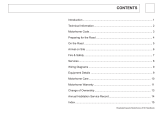
• The exhaust ue hose must not come
into contact with fuel lines, water hoses,
plastic pipes or electrical cables.
• The exhaust ue hose must not be
integrated into any other exhaust or outlet
on the craft.
5:6 Fitting the air intake/ue exhaust
hose
Only instructions regarding the roof
mounted ue is applicable.
5:7 Fitting the expansion tank
“The drain hose (Figure F 18) has to be
tted so that it fol lows the shortest route
from the expansion tank and out through
the oor of the vehicle. Cut the hose obli-
quely under the vehicle at an angle of 30°
facing the rear of the vehicle (Figure G).”
Is replaced by the following:
“The drain hose must be tted so that it fol-
lows the shortest route from the expansion
tank to a suitable secure container or bilge.”
5:8 Connection to the heating system
“The drain hose from the bleeder (Figure
H 23) must be routed through the oor of
the vehicle. Cut the hose obliquely at an
angle of 30° facing the rear of the vehicle
(Figure G).”
Is replaced by the following:
“The drain hose must be tted so that it fol-
lows the shortest route from the expansion
tank to a suitable secure container or bilge”
5:9 Connection to the water system
As it is stated.
5:10 Installation of safety/drain valve
“oor” is replaced by the following: “suita-
ble secure container or bilge”.
5:11 LPG connection
“ • The LPG installation to the boiler has
to be executed using 8 mm copper or ste-
el pipe, and be connected to the boiler’s
gas pipe with a compression coupling.
When routing pipes, bear in mind that all
joints/couplings have to be easily acces-
sible and it has to be possible to disas-
semble the boiler for servicing.
• The LPG connection to the boiler must
have a separate shut-o tap that is easily
accessible.
• The boiler must be connected to an LPG
cylinder with a type-approved reducing
valve with a pressure of 30 mbar.
For increased safety, we recommend tting
an Alde leak detector, type 4071, as close
as possible to the reducing regulator.”
Is replaced by the following:
“The LPG installation to the boiler must
be executed using regulation 8 mm cop-
per, stainless steel or cupronickel pipe,
and be connected to the boiler’s gas pipe
with a compression or cutting-ring com-
pression tting. When routing pipes, bear
in mind that all joints/couplings must be
easily accessible, and it must be possible
to conveniently service the boiler.
The LPG connection to the boiler must
have a separate shut-o valve that is
easily accessible. It is recommended to t
a gas test point on the gas pipe as close
to the boiler as possible.
The boiler must be connected to an LPG
cylinder with a type-approved dual-fuel re-
gulator with a nominal operating pressure
of 30 mbar.”
5:12 Electrical connection
“The boiler must be connected perma-
nently to a 230 VAC supply and be pro-
tected with a 10 A fuse for a 2 kW.”
Is replaced by the following:
“The boiler must be permanently connec-
ted to 230 VAC supply and be protected
by a 16 A MCB and RCD. It is recommen-




